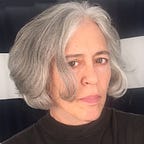We Like Our Cities Big or Small
Why the Mama Bear Size Doesn’t Work
I’ve lived in NYC and Milan, Italy. I’ve spent a lot of time in small towns because they fascinate me. I’m still hoping to find one that is close to enough stuff I want to see and people I know to move there.
But I have also lived for many years in a medium city and I can tell you why I think they don’t work. Medium-sized cities have a hard time being diverse. Oh, yeah, there are rich and poor and everything in between, but for some reason they tend to be segregated.
Medium cities are doughnuts, with the sprinkles on the outside.
If they are blessed with a few good restaurants and music venues or, even better, with a university, there is some hope that people will come in and money will be spent downtown. This is the flyover–drop the money like a turd–fly back syndrome.
The valuable real estate, the better schools, the parks with ball fields, the higher taxes, and the incomes to go with them, are in the ‘burbs. It’s safer, we think. It’s safer without sidewalks, with blank, automatic garage doors that open their gaping jaws to swallow your car so you never have to step foot in the “public realm.” There really isn’t a public realm in the suburbs; it’s called the right-of-way and it’s for cars and buried infrastructure. Fifty feet between the beginning of your front lawn and mine. There’s no way to meet people.
In large cities, and small ones, the action is in the core.
Large and small cities have neighborhoods.
That’s why they are better.
All settlements started out dense, usually near a river or a highway. Then there was urban strife and some planners decided to make a rule about Minimum Lot Sizes. It was healthier. As soon as people could afford it, they moved to the suburban zone. It really should be called extra-urban or exurban.
Once the segregation began, the neighborhoods fell apart. You no longer had the trades where the customers were. Your children didn’t learn how to get along with people who were different from them.
Neighborhoods make cities resilient.
If you take a very large urban center like Brooklyn, you can see that the variety of neighborhoods makes it exciting while providing you with your daily needs close to home. Each one has its personality while being self-sufficient.
I chose Brooklyn and not Manhattan for this example because Manhattan has been losing its neighborhoods en route to becoming a safe deposit box for very tall stone piles owned by wealthy people who don’t really live in New York. It’s skyburbia. You need diversity in property values.
So it’s not hard to understand why people who make it big, or not so big, and decide to leave places like New York choose the little cities that were and remained dense because they sort of died but have come back to life thanks to www.zoom and company. That poses another problem as the big fish tend to eat the little fish wherever they go. Topic for another story.
Neighborhoods have a structure. There are different housing types for different folks with different means. They all live together, ordering capucchinos, serving capucchinos, meeting their friends or colleagues. I sell, you buy; everyone is happy. They are diverse in age, occupation, wealth, sexual orientation, schedules, pastimes, all of which make the orchestra of the neighborhood play beautiful music.
Medium sized-cities could study these social phenomena and do something to change their fabric, like investing in the people who live in the urban core instead of catering to the suburbanites with their flyover turds.
But until then, I think life is richer in a neighborhood.
